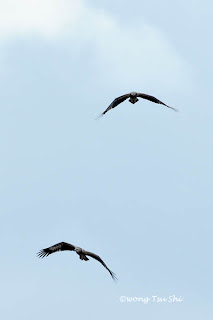Dusky Broadbill Corydon sumatranus brunnescens at 27 cm is the largest broadbill in Borneo, the other large broadbill is the montane Whitehead's Broadbill Calyptomena whiteheadi which is a bit smaller at 25 cm. It is a scarce and uncommon resident sparsely distributed from sea level to montane forests up to 1,220 meters, may be higher to 1,835 meters.
This is a bird of the tree tops and forage in family groups from their tree top perch. It is a dark bird with a pale buff throat and pinkish bill.
I manage to see them in Tawau for the first time, true to its habits, three of them were foraging near the canopy of a tall tree, my lifer and my #324 photographed wild birds of Borneo.
Incidentally, this is my second last Broadbill of Borneo, the last one to be added to complete my Broadbill collection is the super rare Hoses's Broadbill Calyptomena Hosii, wish I have a chance to photograph it one day.
My photo collection of Bornean Broadbills is here.
My photo collection of Bornean Broadbills is here.

























